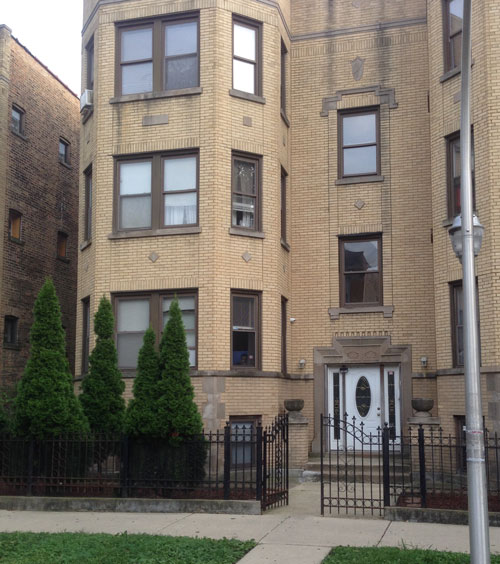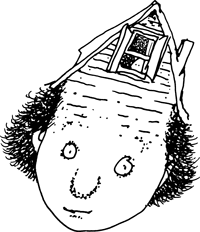
Six-flat at 2853-55 W. Palmer. The Silversteins lived on the 2nd floor.
The Sidewalk's End
Author Sheldon Silverstein was born in Humboldt Park in 1930, but at age 4 he moved with his parents and infant sister Peggy to the second-floor apartment at 2853 W. Palmer, a block south of Lyndale Street. Shel lived here the rest of his childhood until leaving for college, and on-and-off briefly for a few years afterwards.
Silverstein grew up to become a prolific writer, musician and artist with an eclectic career as a cartoonist for Playboy magazine, writer of many one-act plays, songwriter for country and folk superstars, as well as a poet and cartoonist of beloved childrens books.
Lisa Rogak's biography A Boy Named Shel describes Silverstein's childhood as rather melancholy, though charged with imagination. He was an indifferent student at Darwin Elementary, but enjoyed doodling and reading alone in his room at home while listening to country music records and White Sox games on the radio. Silverstein recalled in a 1963 interview with Studs Terkel, "I didn't have a lot of friends. I just walked around a lot and made up stories in my head. Then I'd go home and write them down. That's how I got started."
On his way home from school perhaps the young daydreamer wandered down the sidewalks of Lyndale Street. What sorts of stories might he have imagined about the ordinary little houses there? In the early evening, when the shades were not yet drawn, perhaps he glimpsed the lives of the people inside from a distance.
In his 1981 collection, A Light in the Attic, Silverstein includes a cartoon not unlike one of the little houses on Lyndale Street along with the title poem:

There's a light on in the attic.
Though the house is dark and shuttered,
I can see a flickerin' flutter,
And I know what it's about.
There's a light on in the attic.
I can see it from the outside,
And I know you're on the inside...lookin' out.
Can the present-day wanderer in Logan Square still find such comfort of recognition in the hidden interior life of its houses? The boxy condominium towers going up along Lyndale Street no longer include tiny attics for recluses. In fact, most of them are built in a contemporary style which emphasizes volumes of open space. Tall plate-glass windows expose the entire open floor plan from the living room to the kitchen and rooms at the back.
On an ordinary evening the primary light from such houses comes from oversized TV screens, without curtains or shades to hide the blue flickerin' flutter, and the only flashes of recognition for passersby are of which entertainment channel each room is tuned to. These new dream houses provide plenty of square footage and opportunity for escapism, but is there enough room inside for children and artists to daydream and doodle and make up stories about the houses and sidewalks of the neighborhood?

